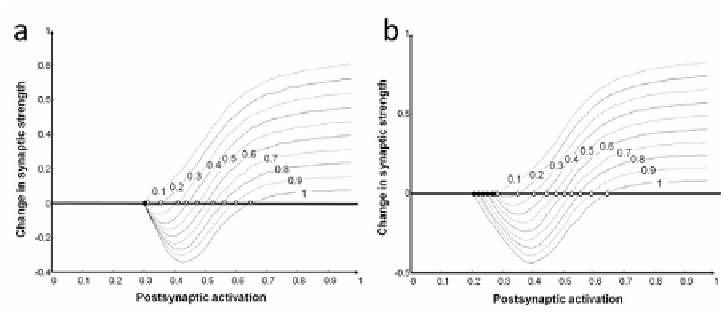Information Technology Reference
In-Depth Information
the neuron output,
o
, is binary and the probability of a unitary output is given
by a non-linear logistic activation function, so that:
o
=
f
∗
(
a
)
(15)
f
∗
being a function that yields a binary 0 or 1 according to the probability given
by
O
, which is the output given by the sigmoid function
f
where
O
=
f
(
a
). Here,
the variation of synaptic weight
ω
ω
0
is calculated for each activation
a
and
for each initial weight
ω
0
by using the probabilistic version of the presynaptic
rule:
ω
=
P
(
i
−
). Binary output o is calculated according to Eq. 15 whereas
binary input
i
is calculated from probability
I
, where in the homosynaptic case,
I
=
a/w
.
When including
a
n
(the postsynaptic activation due to other synapses),
I
is
obtained from equation 10 as:
I
=
[
a
−
a
n
]
+
ω
(16)
Fig. 4.a is the representation of this case. The influence of
a
n
, that was arbitrarily
set to
a
n
=0
.
3 in the example, is observed in the rightward shift of 0.3 units of
the curves in Figure 4.a.
When property A.3 is taken into account, the presynaptic probability,
I
,is
calculated as:
I
=[
a
−
a
n
+
k
]
+
(17)
ω
Fig. 4.b corresponds to this case. There is a leftward shift of the LTD threshold
with greater values of w (i.e. LTD metaplasticity). Without
a
n
, LTD metaplastic-
ity is not present. This property is only manifested in the case of heterosynaptic
plasticity (property B.2).
Fig. 4.
Plasticity curves calculated according to the probabilistic presynaptic equation
using a non-linear activation function (sigmoid). (a) In this case, the curves exhibit LTP
threshold metaplasticity considering heterosynaptic influence according to Eq. 16. (b)
Metaplasticity of the LTD threshold according to equation 17 and considering property
A.3.










Search WWH ::

Custom Search